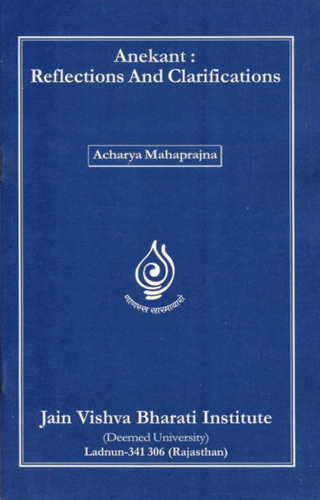Existence has many modes. Three dimensions have been identified for determining the nature of each of these modes; existence, non-existence and inexpressibility. These three dimensions can express the nature of existence. For example, a due of two atoms has two aspects. It exists in its own nature, but it does not exist from the point of view of the nature of another entity. An example of atom in modern science may be given—The hydrogen atom consists of two particles—one electron and one proton. The electron has a negative charge and the proton a positive charge. The electron rotates in the circumference, while the proton is stationary in the nucleus. Thus both are opposite to each other. It can be said that the electron is real from the point of view of its own nature, but non-real from the point of view of the nature of proton.
Here a doubt may be raised - when it is a commonplace knowledge that anything is not real from the point of view of opposite nature, why should it be propounded as a theory? For example, Dr. Daya Krishna has raised the question - 'The negative characterization, however, is both too wide and too vacuous to be regarded as significant in terms of actual predication, for if, say, there is such a thing as a red rose and we are saying that 'this rose is red' we are not only denying that it has other colours, but also the fact that it is an elephant or any of the other myriad things which are not meant by the term rose in English language. But what could possibly be meant by saying that the object designated by the term 'rose' is not any of these things? It is, of course, being assumed that the other terms are not synonymous of the term rose', just as it is being assumed that the term 'rose', itself a homonym designating other things, is used in different contexts."
The question raised here can be summarily answered thus: The atoms constituting the rose flower have assumed the form of rose at present; they were not so in the past nor will they be so in the future. Therefore, the atoms constituting the rose are rose from the point of view of present times, but they are not rose from the point of view of past or future. Svami Visuddhanandaji, the Guru of Dr. Gopināth Kaviraj, is said to have the capacity to change the rose into stone and vice-versa, through the solar science. Another example is that of water. 'This is water - this statement pertains to the present mode. It would change into oxygen and hydrogen as the process of electrolysis takes place through electricity. (If water is required, the reverse process will transform the air into water).
In these cases the rose (or water) is real from the point of view of the present mode, but it is not real from the point of view of past or future. Therefore, positive and negative statements are made by showing the relativity of the modes of past, present and future.
A substance has two-fold powers: one is the power to hold its own self. This is the quality of agurulaghu, which is propounded through a positive statement. The other power is that of keeping one's existence independent of others so that an entity can exist separately, and does not lose its identity. This power is stated through a negative statement, the positive and negative statements are thus not imaginative; their usages are not redundant. A single positive statement cannot describe what it is and what it is not. The rose flower is different from that of dhatura is a case of empirical knowledge, needing no positive-cum-negative statement. But a positive-cum-negative statement is required to show why they are different. Both of them are essentially nothing but matter (or pudgalāstikāya). The molecules forming the rose are different from those of the dhatura flower. Therefore, the rose flower is keeping its entity separate from that of the dhatura. If the molecules of both the flowers had identical mode, rose would have been dhatura and dhatura would have been rose. Only the positive statement could not have propounded the identity-cum-difference or unity-cum-diversity.
The rose flower is a mode of pudgalāstikāya (which is one of the ultimate substances) and so is the flower of dhaturā. At present, modes of both are different. In future, it is possible that the molecules which have taken the form of dhaturā flower may take the form of rose flower, and vice-versa. But, without showing the separation of molecules which have assumed the form of rose from those which have assumed the form of dhaturā, it would not be possible for us to identify objects—that is to say, the system of objects would become impossible. For a layman, rose and dhaturā are evidently different; for a person who knows the law of transformation, they are not absolutely different; both of them being the modifications of the molecules of matter (pudgala). But this modification may change also in future. From the point of view of eternity, we would like to say that as both the flowers are modifications of molecules, they are, identical. But from the point of view of present, we cannot accept them as identical. Therefore, we should have the knowledge of both, the positive and the negative (i.e., what it is, and what it is not).
The third alternative of 'unspeakable' in syādvāda is not the same as the inexpressibility of Brahman in the Vedanta philosophy. When we have the existence of the present mode, we have the nonexistence of the future mode at the same time. Both cannot be simultaneously expressed; we have, therefore, to take resort to the third alternative of unspeakability. This is the limitation of the language that though both can be known simultaneously, yet they cannot be expressed simultaneously.
 Acharya Mahaprajna
Acharya Mahaprajna
 Publisher:
Publisher: 